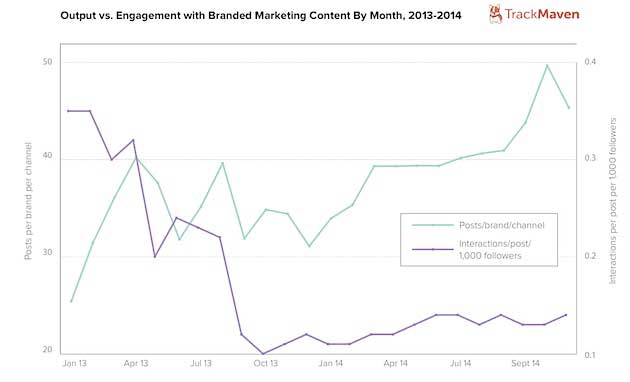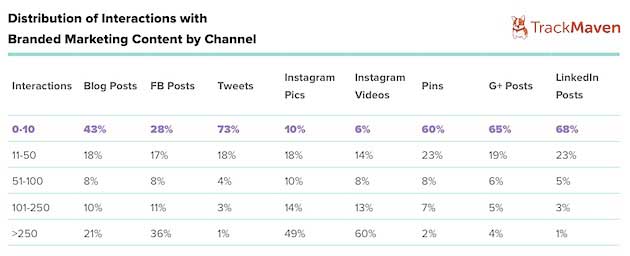Brands are producing much more content now, but the engagement with each piece of content is less than it was two years ago, according to a recent report from Track Maven.
The report was based on 24 months of marketing activity (January 2013 through December 2014) for 8,800 B2C and B2B brands, including 7.2 billion combined interactions on 13.8 million pieces of content across seven digital marketing channels (blogs, Facebook, Twitter, Instagram, Pinterest, Google+, and LinkedIn).
The analysis found the output of content per brand increased 78%, on average, from the start of 2013 to the end of 2014, but content engagement decreased 60%, on average. In other words, brands are generating a higher volume of content per channel, but individual pieces of content are receiving fewer interactions (clicks, likes, comments, favorites, retweets, etc.) per 1,000 followers.
Nearly a quarter (23%) of brand-generated blog posts receive zero interactions, according to the analysis. Moreover, nearly half of all brand blog posts (43%) receive 10 or fewer interactions.
On Twitter, Pinterest, Google+, and LinkedIn, more than half of all posts receive fewer than 10 interactions (73%, 60%, 65%, and 68%, respectively).
Twitter has the lowest average engagement of the social networks examined, with 73% of tweets receiving 10 or fewer interactions.
Instagram has the highest average engagement; just 10% of Instagram photos and 6% of Instagram videos receive 10 or fewer interactions. Instagram also has the highest percentage of viral content, with 49% of Instagram photos and 60% of Instagram videos receiving more than 250 interactions.
Facebook has the second-highest percentage of content with more than 250 interactions (36%). On Facebook, sponsored content now accounts for the vast majority of posts that have more than 250 interactions, the analysis found.
About the research: The report was based on 24 months of marketing activity (January 2013 through December 2014) for 8,800 B2C and B2B brands, including 7.2 billion combined interactions on 13.8 million pieces of content across seven digital marketing channels (blogs, Facebook, Twitter, Instagram, Pinterest, Google+, and LinkedIn).






